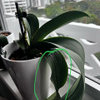Caring for Oxalis
leira
18 years ago
Related Stories

LANDSCAPE DESIGN7 Low-Maintenance Lawn Alternatives
Turf isn't the only ground cover in town. Get a lush no-grass lawn with clover, moss and other easy-care plants
Full Story
GARDENING GUIDES8 New Ways to Garden This Year
A successful garden means knowing the plants, the wildlife and yourself
Full Story
GARDENING GUIDESWeed War: When and How to Use Chemical Herbicides
Before you spray, arm yourself with knowledge about which weed killers — natural or synthetic — are right for your yard
Full Story
EDIBLE GARDENSNatural Ways to Get Rid of Weeds in Your Garden
Use these techniques to help prevent the spread of weeds and to learn about your soil
Full Story
HOUSEPLANTS8 Essentials for Healthy Indoor Plants
Houseplants add so much to our homes — and can thrive when grown in the right conditions. Keep these tips in mind
Full Story
HOUSEPLANTSCelebrate Shamrocks on St. Patrick’s Day
Two bright green perennials are perfect March additions to your houseplant collection
Full Story
HOUSEPLANTSIndoor Winter Gardens for Cheerier Days
Bring plants inside for drab-days mood boosting — not to mention cleaner indoor air and protection for your greenery
Full Story
GARDENING GUIDESGreat Design Plant: Bugle Weed, a Quick Ground Cover
It’s highly adaptable, suppresses weeds, reduces erosion and provide weeks of bright flowers. Just watch for invasiveness
Full Story
LANDSCAPE DESIGNGarden Overhaul: Which Plants Should Stay, Which Should Go?
Learning how to inventory your plants is the first step in dealing with an overgrown landscape
Full Story
GROUND COVERSNative Alternatives to English Ivy, Japanese Pachysandra and Periwinkle
These shade-loving ground covers are good for the environment and say something about where you are
Full StoryMore Discussions









cali_4j
webkat5
Related Professionals
Glen Ellyn Landscape Architects & Landscape Designers · Signal Hill Landscape Architects & Landscape Designers · Suffern Landscape Architects & Landscape Designers · Wilmington Landscape Contractors · Belmont Landscape Contractors · Bound Brook Landscape Contractors · Burlington Landscape Contractors · Byram Landscape Contractors · Cockeysville Landscape Contractors · Lake Saint Louis Landscape Contractors · Lees Summit Landscape Contractors · North Plainfield Landscape Contractors · Oak Harbor Landscape Contractors · Birmingham Interior Designers & Decorators · Ogden Interior Designers & Decoratorscali_4j
webkat5
cali_4j
webkat5
KTEED_SENT_COM
sandy9618
birdsnblooms
alisonmann1_mac_com
birdsnblooms
tlcactus
mingtea
vieja_gw
ameliamcmahon_hotmail_com
tapla (mid-Michigan, USDA z5b-6a)
meyermike_1micha
amccour
tapla (mid-Michigan, USDA z5b-6a)
amccour
rabbithole2020
birdsnblooms
tapla (mid-Michigan, USDA z5b-6a)
rabbithole2020
jojosplants
birdsnblooms
jojosplants
rabbithole2020
jodik_gw
greenman28 NorCal 7b/8a
rabbithole2020
jodik_gw
rabbithole2020
jodik_gw
birdsnblooms
tapla (mid-Michigan, USDA z5b-6a)
jojosplants
birdsnblooms
tapla (mid-Michigan, USDA z5b-6a)
birdsnblooms
tapla (mid-Michigan, USDA z5b-6a)
birdsnblooms
whitehouselm
tapla (mid-Michigan, USDA z5b-6a)
raistlyn
birdsnblooms
EdwinR
fireflygirl777
simpleliving_one
vieja_gw